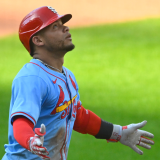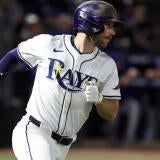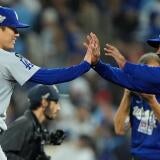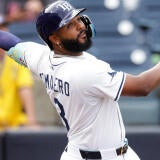Fantasy Baseball: Frank Stampfl breaks down his coveted 2021 Tout Wars H2H championship
Discipline and flexibility are key in Salary Cap drafts
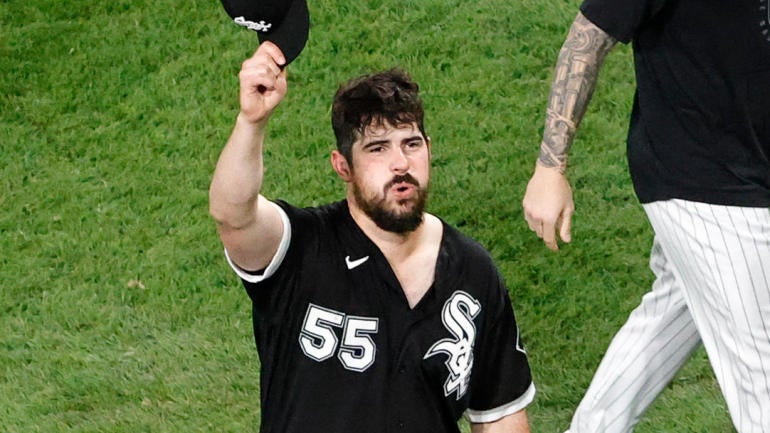
Everybody remembers their first.
No matter how many years you've been playing Fantasy sports and how many championships you've won, you always remember your first. No, this isn't my first ever championship but it is, however, my first ever Tout Wars victory.
For those that don't know, Tout Wars is a collection of Fantasy Baseball analysts competing against each other in various formats. There are now seven different leagues including a 15-team mixed draft, 15-team Salary Cap draft, 12-team AL-only, 12-team NL-only, 12-team mixed draft, 15-team draft-and-hold, and a 12-team head-to-head points Salary Cap draft. Aside from the H2H points league, each league is a Rotisserie format and speaking of which, our very own Scott White won the 15-team mixed last year!
More than the competition, Tout Wars is a reason for everybody to meet up in New York City as the unofficial start to the baseball season. That's what makes this victory so important to me. For years I would travel into Manhattan to watch my industry favorites shout out numbers as they competed against each other. Yes, I would actually stand in the back of a room watching strange middle-aged people bid on players. What can I say? I was obsessed.
This is actually where I originally met 'The King,' Scott Engel, who gave me my first real opportunity in this industry. For my O.G. Fantasy Baseball Today listeners out there, I also remember interacting with Al Melchior and Nando Di Fino for the first time at this event. I was star struck. All I can remember thinking was that I wanted to be part of this one day and that's what makes this so special.
Unfortunately, due to COVID-19, all in-person drafts and festivities were canceled in 2021, forcing each of us to draft online. Here's to hoping for a return to normalcy in 2022, where I can have Chicken Fingers named after me on the Tout Wars Champion menu.
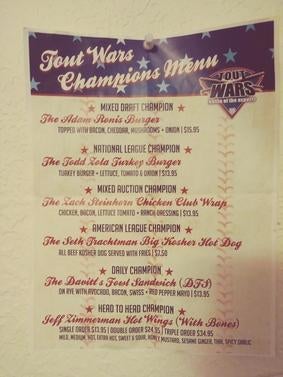
Alright, alright. Enough of the mush, I swear. How did I manage to win this league? Discipline, flexibility, drafting my biggest preseason bust and, of course, a little bit of luck. You hear about discipline a lot in Salary Cap drafts, but what does it really mean? It's the ability to set limits on yourself. Everybody handles Salary Cap drafts differently. For me, I literally map out my entire draft beforehand. I open up an auction calculator, punch in my league settings and generate. It definitely doesn't hurt that I use ATC projections considering the creator of those projections, Ariel Cohen, made it to the finals against me in this very Tout Wars league (shout out to Ariel, great dude). That gives me a general idea of what a player should be worth, though I do compare with other Salary Cap values in the industry.
From there I map out the players I want at each position and how much I'm willing to pay for them. A big part of my discipline this year was knowing I did not want to spend much more than $30 on any single player. That's going to be hard for some because that means you don't have access to the Fernando Tatis' or Gerrit Cole's of the world. I was alright with that. Typically, the deeper the league, the more balanced I want my team to be. While this is a H2H Points league, it uses a Roto-style lineup. That means two catchers, five outfielders, a corner infielder, middle infielder, and nine pitchers (seven starting pitchers, two relief pitchers).
From there I find the players I want to spend on heading into the draft. Based on this scoring format, I knew I wanted one of Alex Bregman or Anthony Rendon at third base and one of Xander Bogaerts or Corey Seager at shortstop. Those were set to be the anchors of my offense. On the pitching side, I knew I wouldn't be in on Cole or Jacob deGrom but I wanted two pitchers in that next tier, the $25-30 range. With that being said, I always have lower-priced players in mind as a backup plan, in case I get priced out. How did my plan go? Was I able to execute?
OPENING DAY ROSTER (SALARY CAP VALUE IN PARENTHESIS)
C- Willson Contreras ($11)
C- Yadier Molina ($1)
1B- Eric Hosmer ($5)
2B- Jose Altuve ($12)
3B- Alex Bregman ($28)
SS- Fransisco Lindor ($26)
CI- Ke'Bryan Hayes ($9)
MI- Nick Solak ($3)
OF- Nick Castellanos ($22)
OF- Eddie Rosario ($11)
OF- Mike Yastrzemski ($9)
OF- Dylan Carlson ($7)
OF- Andrew McCutchen ($3)
UTIL- Carlos Santana ($6)
58.8% of my budget on hitting
SP- Max Scherzer ($31)
SP- Max Fried ($18)
SP- Chris Paddack ($12)
SP- Pablo Lopez ($11)
SP- Charlie Morton ($11)
SP- Marcus Stroman ($10)
SP- Aaron Civale ($9)
RP- Trevor Rosenthal ($4)
RP- Will Smith ($1)
41.2% of my budget on pitching
Reserve rounds:
Well, that escalated quickly. While I wound up with some players I planned on getting like Bregman, Nick Castellanos, and Jose Altuve, there were definitely a few surprises along the way. For example, I had no plans to wind up with Francisco Lindor but when he started slowing down around the $20 range, I decided to jump in. Eric Hosmer was definitely not my Plan A at first base plus I wanted one of those utility-only bats in Yordan Alvarez or Giancarlo Stanton. I got priced out on both but had a backup plan in place. That's where the discipline and prep before the draft come into play.
You can also see that I did not wind up with two elite starting pitchers. In fact, I wound up with the one ace I was most consistently calling a bust during draft season: Max Scherzer. How could this possibly happen? This is where you need to be flexible. I loved Aaron Nola and Luis Castillo coming into the season. The problem was that Nola went for $38 in this draft while Castillo went for $32. I had both priced in the $25-30 range. I was in on the bidding for both but I set my limits. That told me there was inflation on aces in this league and, based on the H2H points format, it made sense. I wound up with Scherzer because, while I was scared of his bust potential, I still had him in the same tier as these other pitchers. On top of that, he came the cheapest of the group. Scherzer wound up being the 10th highest-priced starting pitcher in the draft.
Once I realized I had missed out on a second ace, I turned my attention to mid-tier starting pitchers. I wound up with six pitchers between $9 and $18 and that's where luck plays a factor. It turns out that 2021 was the year to use this exact strategy. While I didn't land the breakout Kevin Gausmans or Joe Musgroves of the world, Max Fried, Charlie Morton, and Marcus Stroman all out-performed their draft cost. There are also two names down there in the reserve rounds that helped out quite a bit in Framber Valdez and Carlos Rodon. I went into each of my drafts hoping to stash one of Valdez, Chris Sale, Luis Severino, or Noah Syndergaard on the Injured List. It just so happens that I wound up with the most productive one of that group. While Rodon faded down the stretch, he finished the season as the SP12 in fantasy points per game. Again, luck will always be factor in anybody winning a Fantasy Baseball championship.
That was the draft process. I can't emphasize enough to be disciplined in your values but also flexible in your strategy. It's a fine line. I usually have a $2-3 range I'm willing to spend on any given player. I knew I was willing to spend $26-28 on Bregman and I won him at $28. I knew I wanted one of those elite shortstops at $24-26. I wound up with Lindor at $26. Pay very close attention to how much players are going for early in the bidding process. Once you have a sample of 5-10 players drafted, you can compare how much they went for to how much you had them projected. From there, you can figure out how aggressive your league mates and what level of inflation you can expect for similarly ranked players.
Of course the draft is only half the battle. You have to be aggressive on FAB in-season and capitalize on others mistakes. That's how I wound up with Robbie Grossman and Charlie Blackmon. While they weren't league-winners, they were steady contributors in the second. You also need to be aggressive with emerging players. That's how I wound up with Ty France, Lane Thomas, Elias Diaz, Joe Ryan, Logan Gilbert, Shane Baz and many more throughout the season. For the most part, top prospects were a letdown in 2021 but all three of Ryan, Gilbert, and Baz were massive down the stretch.
It's always fun to compare your final roster vs. Opening Day. How'd it look for me?
FINAL ROSTER
C- Willson Contreras (draft)
C- Elias Diaz (free agent)
1B- Ty France (free agent)
2B- Jose Altuve (draft)
3B- Alex Bregman (draft)
SS- Francisco Lindor (draft)
CI- Cavan Biggio (free agent)
MI- Alcides Escobar (free agent)
OF- Nick Castellanos (draft)
OF- Dylan Carlson (draft)
OF- Robbie Grossman (free agent)
OF- Charlie Blackmon (free agent)
OF- Lane Thomas (free agent)
UTIL- Myles Straw (free agent)
SP- Max Scherzer (draft)
SP- Max Fried (draft)
SP- Charlie Morton (draft)
SP- Marcus Stroman (draft)
SP- Framber Valdez (draft)
SP- Shane Baz (free agent)
SP- Drew Rasmussen (free agent)
RP- Will Smith (draft)
RP- Ian Kennedy (free agent)
Reserves
Aaron Civale
Carlos Rodon
Logan Gilbert
Joe Ryan

